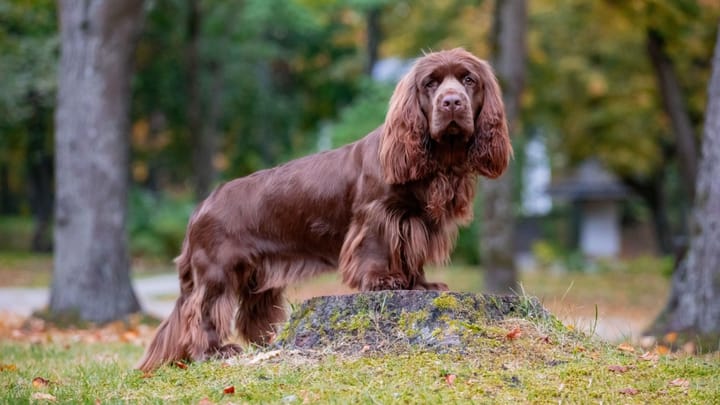Sussex Spaniel

The Sussex Spaniel is a native British breed with a wonderfully cheerful, relaxed and gentle temperament. Originally used as a slow-but-steady gundog, the golden- liver-coated breed eventually gained popularity as a good-natured companion dog. Good with children, relaxed within the home and a lover of family life, the Sussex Spaniel is a great choice of dog for an active family household.
|
Life expectancy |
The Sussex Spaniel has a life expectancy of between 10 and 14 years |
|
Temperament |
|
|
Size |
Medium
|
|
Adult size |
Female
Between 15 and 16 in
Male
Between 15 and 16 in
|
|
Adult weight |
Female
Between 44 and 55 lb
Male
Between 44 and 55 lb
|
|
Coat colour
The coat is an intense golden brown. |
Brown |
|
Type of coat
The coat is abundant, feathery, thick, and weather-resistant. |
Long |
|
Eye colour
The eyes are hazel or brown. |
Brown
|
|
Purchase price |
The Sussex Spaniel costs between £400 and £600 |
The stunning golden-liver colour of this breed’s coat is completely unique to the Sussex Spaniel. Yep, it’s truly one of a kind!
More details about the Sussex Spaniel
Sussex Spaniel: Origins and history
The Sussex Spaniel originates from, you guessed it, Sussex in the UK in the early 1800’s and is actually one of the oldest native British breeds around. A famous Sussex Spaniel enthusiast called Mr. Fuller bred the Sussex Spaniel for 50 years, allowing the breed to flourish. However, breed population dropped significantly after WWII, with only 7 Sussex Spaniels left in known existence. Thankfully, breed enthusiasts got their game on and managed to save the breed from extinction - however, numbers are still relatively low to this day.
Physical characteristics of the Sussex Spaniel
The Sussex Spaniel is a medium-sized dog which, although similar to other Spaniel breeds in appearance, is distinguishable by its larger head. This is a low-built yet robust and sturdy breed with muscular limbs, deep chest and well-muscled back. In fact, just by glancing at the Sussex Spaniel’s frame, it’s easy to see that the breed is built for strength and endurance. In terms of the head, the Sussex boasts adorable wavy-haired floppy ears, large brown eyes and a signature ‘frowny’ expression that belies this breed’s very cheerful nature.
FCI classification of the Sussex Spaniel
-
Group 8 - Retrievers - Flushing Dogs - Water Dogs
-
Section 2 : Flushing Dogs
Sussex Spaniel: Characteristics
Sussex Spaniel: Behaviour
Training a Sussex Spaniel
The Sussex Spaniel is highly trainable and capable of becoming an extremely obedient pooch with patient and consistent training to set firm boundaries. This breed, like many Spaniels, is rather sensitive in nature and won’t react well to negative or harsh training methods. Kind, gentle and positive training sessions are the way forward.
Sussex Spaniel: Lifestyle
Breed compatibility Sussex Spaniel
Sussex Spaniel: Purchase price
Looking after a dog of this size typically costs between £60 to £90 a month, including food, medical/insurance, and incidental expenses.
Sussex Spaniel: Shedding
Average
Shedding is moderate for this breed.
Sussex Spaniel: Grooming
This breed is quite high-maintenance in the grooming department, which is something to consider before taking one on. The Sussex’s gorgeous coat will need brushing daily, with special attention given to the ears, armpits and groin areas, which can become tangled and matted very easily. The ears are prone to infection and require regular checks and cleaning.
Sussex Spaniel: Health
The average life expectancy for this breed is 13 years.
In comparison to other medium-sized breeds, the Sussex Spaniel is very robust.
Although the Sussex Spaniel prefers colder climates, this hardy breed can tolerate warmer temperatures as long as water and shade are available.
The Sussex Spaniel has a thick, weather-resistant coat and is highly tolerant of cold temperatures.
As long as you make sure to exercise your dog well, and measure out food portions correctly, this breed should stay in a healthy weight range.
- Hip dysplasia
- Phosphofructokinase Deficiency (PFK)
- Pyruvate Dehydrogenase Phosphatase Deficiency (PDP1)
- Multifocal retinal dysplasia (MRD)
- Congenital deafness
- Allergies
- Ear problems
- Bloat



